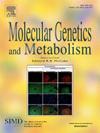The value of MR spectroscopy and MR elastography in assessing hepatic involvement of chronic visceral acid sphingomyelinase deficiency in adults
IF 3.5
2区 生物学
Q2 ENDOCRINOLOGY & METABOLISM
引用次数: 0
Abstract
Hepatic involvement is one of the main visceral manifestations of Acid Sphingomyelinase Deficiency (ASMD). It can lead to liver fibrosis and liver failure in a subset of patients. Better understanding of the boundary between reversible and irreversible liver involvement is important to initiate enzyme replacement therapy at the right moment. Currently, liver enzymes and liver stiffness measured with transient elastography (TE) are used to assess liver involvement of ASMD. The aim of this study was to investigate whether magnetic resonance (MR) techniques such as MR spectroscopy (MRS) and MR elastography (MRE) are useful methods to measure liver involvement of ASMD and whether they are more useful than TE.
Thirteen therapy-naïve adult ASMD patients with the chronic visceral subtype and eleven age-, sex- and body mass index-matched healthy controls were recruited. All participants underwent MRS and MRE scans and had blood drawn for the measurement of liver enzymes. For patients data of TE and biochemical plasma markers for ASMD were collected.
Median fat fraction measured with MRS and median liver stiffness measured with MRE did not differ significantly between ASMD patients and healthy controls (respectively median PDFF 1.0 %, range 0.2–24.2 % for patients and median PDFF 0.7 %, range 0.2–8.4 % for healthy controls, p = 0.49 and median liver stiffness 1.2 m/s, range 0.9–1.4 m/s for patients and median liver stiffness 1.3 m/s, range 1.1–1.4 m/s for healthy controls, p = 0.86). A significant correlation was observed between liver stiffness measured with MRE and liver stiffness measured with TE (R = 0.74, p = 0.014). The MRS spectra showed no specific sphingomyelin peaks. At this moment, TE seems the best method to monitor liver stiffness for adult patients with chronic visceral ASMD.
磁共振光谱和磁共振弹性成像在评估成人慢性内脏酸性鞘磷脂酶缺乏症累及肝脏中的价值
肝脏受累是酸性鞘磷脂酶缺乏症(ASMD)的主要内脏表现之一。它可导致部分患者肝纤维化和肝功能衰竭。更好地了解可逆性和不可逆性肝脏受累之间的界限对于在适当的时候启动酶替代治疗是很重要的。目前,用瞬时弹性成像(TE)测量肝酶和肝硬度用于评估ASMD的肝脏受累。本研究的目的是探讨磁共振(MR)技术,如磁共振光谱(MRS)和磁共振弹性成像(MRE)是否是测量ASMD肝脏受累的有用方法,以及它们是否比TE更有用。招募了13名therapy-naïve慢性内脏亚型成年ASMD患者和11名年龄、性别和体重指数匹配的健康对照。所有参与者都接受了核磁共振和核磁共振扫描,并抽血测量肝酶。收集患者TE及ASMD生化血浆标志物数据。在ASMD患者和健康对照组之间,MRS测量的中位脂肪分数和MRE测量的中位肝硬度无显著差异(患者的中位PDFF分别为1.0%,范围为0.2 - 24.2%;健康对照组的中位PDFF为0.7%,范围为0.2 - 8.4%,p = 0.49;健康对照组的中位肝硬度为1.2 m/s,范围为0.9-1.4 m/s;健康对照组的中位肝硬度为1.3 m/s,范围为1.1-1.4 m/s, p = 0.86)。MRE法测定的肝脏硬度与TE法测定的肝脏硬度有显著相关性(R = 0.74, p = 0.014)。MRS谱未见特定的鞘磷脂峰。目前,TE似乎是监测成人慢性内脏性ASMD患者肝脏僵硬度的最佳方法。
本文章由计算机程序翻译,如有差异,请以英文原文为准。
求助全文
约1分钟内获得全文
求助全文
来源期刊

Molecular genetics and metabolism
生物-生化与分子生物学
CiteScore
5.90
自引率
7.90%
发文量
621
审稿时长
34 days
期刊介绍:
Molecular Genetics and Metabolism contributes to the understanding of the metabolic and molecular basis of disease. This peer reviewed journal publishes articles describing investigations that use the tools of biochemical genetics and molecular genetics for studies of normal and disease states in humans and animal models.
 求助内容:
求助内容: 应助结果提醒方式:
应助结果提醒方式:


